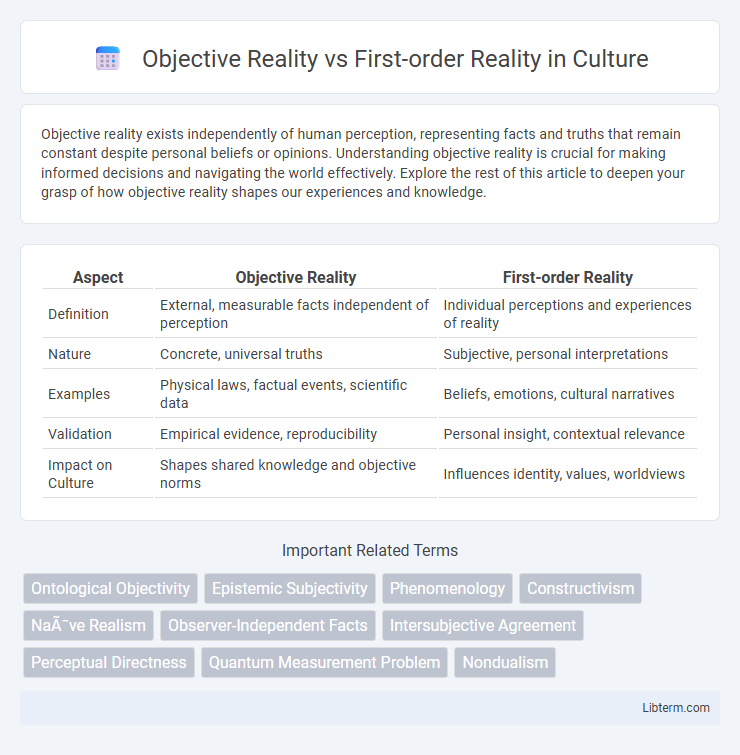Objective reality exists independently of human perception, representing facts and truths that remain constant despite personal beliefs or opinions. Understanding objective reality is crucial for making informed decisions and navigating the world effectively. Explore the rest of this article to deepen your grasp of how objective reality shapes our experiences and knowledge.
Table of Comparison
| Aspect | Objective Reality | First-order Reality |
|---|---|---|
| Definition | External, measurable facts independent of perception | Individual perceptions and experiences of reality |
| Nature | Concrete, universal truths | Subjective, personal interpretations |
| Examples | Physical laws, factual events, scientific data | Beliefs, emotions, cultural narratives |
| Validation | Empirical evidence, reproducibility | Personal insight, contextual relevance |
| Impact on Culture | Shapes shared knowledge and objective norms | Influences identity, values, worldviews |
Defining Objective Reality
Objective reality refers to the existence of the external world independent of individual perceptions or beliefs, encompassing physical objects, natural phenomena, and measurable facts that persist regardless of human observation. It is characterized by its uniformity and consistency, allowing scientific inquiry and empirical validation through observation, experimentation, and logic. Defining objective reality requires distinguishing it from subjective or first-order realities, which are inherently tied to personal experience and consciousness.
Understanding First-order Reality
First-order reality refers to the direct, experiential world as perceived through human senses and immediate consciousness, encompassing tangible objects and events present in real time. Understanding first-order reality involves recognizing its subjective nature, shaped by individual perception, context, and cognitive frameworks, making it a foundational layer for constructing meaning and interaction. This contrasts with objective reality, which denotes an external, observer-independent existence verifiable through empirical evidence and scientific methods.
Key Differences Between Objective and First-order Reality
Objective reality refers to the external world as it exists independently of perception, characterized by measurable and verifiable phenomena, while first-order reality involves direct sensory experience and subjective interpretation. The key differences lie in objectivity versus subjectivity, where objective reality emphasizes factual existence beyond individual bias, and first-order reality centers on personal awareness and immediate experience. Consequently, objective reality aims for consensus and repeatability in observations, whereas first-order reality varies based on individual consciousness and context.
Philosophical Foundations of Reality Concepts
Objective reality refers to the existence of the world independent of perception, grounded in physical and measurable phenomena. First-order reality emphasizes the immediate, experiential level of reality as directly encountered by consciousness, highlighting perception as fundamental. Philosophical foundations explore how these realities intersect, debating whether objective reality is accessible only through subjective experience or exists autonomously beyond human cognition.
The Role of Perception in Shaping Reality
Perception plays a crucial role in shaping the distinction between objective reality and first-order reality, where objective reality refers to the world as it exists independently of human awareness, and first-order reality encompasses the subjective experiences and interpretations individuals have of that world. Cognitive processes filter sensory input, creating personalized models that influence how reality is understood and interacted with. This interaction between objective facts and perceptual constructs underscores the dynamic nature of reality as both an external and internal phenomenon.
Implications for Science and Knowledge
Objective reality refers to the existence of entities and phenomena independent of human perception, forming the foundation of empirical science. First-order reality denotes the direct, experiential reality perceived by individuals, which can be subjective and varies across observers. The distinction implies that scientific knowledge aims to transcend first-order interpretations by employing objective methodologies to establish reliable, reproducible facts about the external world.
Objective Truth: Myth or Measurable Fact?
Objective truth refers to facts that exist independently of perception, grounded in measurable, empirical evidence. It contrasts with first-order reality, which encompasses subjective experiences and individual interpretations that may vary across observers. Scientific methods aim to distinguish objective truth by eliminating bias and verifying results through reproducible experiments.
The Influence of Cognitive Biases
Cognitive biases significantly distort perceptions of objective reality by filtering and interpreting sensory information through subjective experiences and mental shortcuts. First-order reality refers to the actual state of the external world, while cognitive biases shape first-order perceptions into biased or erroneous interpretations, impacting decision-making and beliefs. Understanding the influence of confirmation bias, anchoring, and availability heuristics is crucial to mitigating misrepresentations between objective reality and perceived first-order reality.
Reality in Artificial Intelligence and Virtual Worlds
Objective reality in artificial intelligence and virtual worlds refers to the physical environment and tangible data that AI systems process and interpret, grounded in sensor inputs and real-world parameters. First-order reality in these contexts involves the direct experience within virtual environments, where AI agents interact with simulated elements that mimic or alter sensory perceptions and physical laws. Understanding the distinction enhances AI development for immersive simulations, enabling realistic decision-making and adaptive behavior in both virtual and augmented realities.
Bridging the Gap: Reconciling Objective and First-order Realities
Bridging the gap between objective reality and first-order reality involves integrating empirical data with subjective human experiences to create a comprehensive understanding of existence. Objective reality refers to the external, measurable world governed by physical laws, while first-order reality encompasses personal perceptions and consciousness. Reconciling these dimensions requires interdisciplinary approaches combining neuroscience, philosophy, and physics to align objective truths with lived experiences.
Objective Reality Infographic

 libterm.com
libterm.com